Notizie per Categorie
Articoli Recenti
- [In preview] Public Preview: Azure Storage Mover adds free, direct AWS S3-to-Azure Blob migration 7 Luglio 2025
- Learn how to build an AI-powered, unified SOC in new Microsoft e-book 7 Luglio 2025
- [Launched] Generally Available: Latest PostgreSQL minor versions supported by Azure Database for PostgreSQL flexible server 2 Luglio 2025
- [Launched] Generally Available: Azure DNS security policy 2 Luglio 2025
- [In preview] Public Preview: Azure SQL updates for early-July 2025 2 Luglio 2025
- [Launched] Generally Available: Azure SQL updates for early-July 2025 2 Luglio 2025
- Retirement: VM Insights Map and Dependency Agent are being on June 30, 2028 2 Luglio 2025
- Planning your move to Microsoft Defender portal for all Microsoft Sentinel customers 1 Luglio 2025
- [Launched] Generally Available: Azure App Service on Azure Stack Hub 25R1 1 Luglio 2025
- Jasper Sleet: North Korean remote IT workers’ evolving tactics to infiltrate organizations 30 Giugno 2025
Accelerate automotive transformation with new solutions from Microsoft
In today’s era of AI, accelerated innovation is an ever-present challenge for businesses. They are concurrently facing budget and time-to-market constraints while customer expectations continue to mature and evolve, particularly in automotive, mobility, and transportation. The right technology to face these challenges must drive transformation and deliver more value in less time.
Microsoft automotive, mobility, and transportation reference architectures
To support businesses in meeting these goals, Microsoft announced three mobility reference architectures at CES 2023. In 2024, we are adding four new reference architectures to our industry portfolio. These new resources help our partner ecosystem support their customers in driving the future of mobility across research and development, manufacturing, supply chain and logistics, marketing, sales, and aftersales.
Microsoft mobility documentation
Make the most of mobility with docs and supported reference architectures
Microsoft reference architectures for mobility
- Software defined vehicle toolchain new
- Mobility Copilot new
- Azure Innovation Accelerator new
- Autonomous vehicle operations
- Connected fleets
- Unified view of the customer new
- Digital selling
Microsoft reference architectures are designed to provide structure and guidance for project managers, enterprise architects, and IT managers to deliver agile business outcomes. Solutions utilizing the mobility industry reference architectures are available through qualified partners and Microsoft industry solutions.
Software defined vehicle toolchain reference architecture
The software defined vehicle (SDV) toolchain reference architecture enables a modern cloud-native software development toolchain leveraging strong developer tooling services with additional functionality specific to automotive. The reference architecture covers continuous development, testing, and delivery of high-quality software.
This plug-and-play approach provides the following benefits:
- Reduces the time to onboard new developers and increases code quality using generative AI.
- Accelerates development, testing, and validation of automotive software by shifting left—testing earlier and more often in the development process to improve software quality and development speed.
- Reduces reliance on in-vehicle silicon with highly configurable and flexible virtual electronic control unit (ECU) and virtualized hardware in the loop (HiL) environments on Microsoft Azure.
- Supports compatibility with edge and in-vehicle silicon by offering equivalent compute on Azure.
- Supports the validation process by having a common infrastructure for deploying software artifacts from verification through software-in-the-loop (SiL) to test fleets and collecting “interesting data” to drive changes to the software.
The SDV reference architecture includes the following elements:
- Development tooling using proven Microsoft tools to increase developer productivity and collaboration such as GitHub, GitHub Copilot, Microsoft Dev Box, and Visual Studio Code. These tools are extensible with automotive-specific functionality from partners.
- The SDV development, validation, and integration reference architecture provides orchestration services that allow you to manage deployment environments and target configurations to accelerate your testing and verification on virtual ECU and virtual HiL solutions in the cloud.
- Azure services provide foundational capabilities, such as deployment environments, compute virtualization, and data storage. Microsoft Fabric provides data and analytics services.
- Azure networking provides connectivity to on-premises, HiL validation environments.
- The Azure and GitHub marketplaces simplify integration of partner offerings for tooling and virtual images.
Azure marketplace
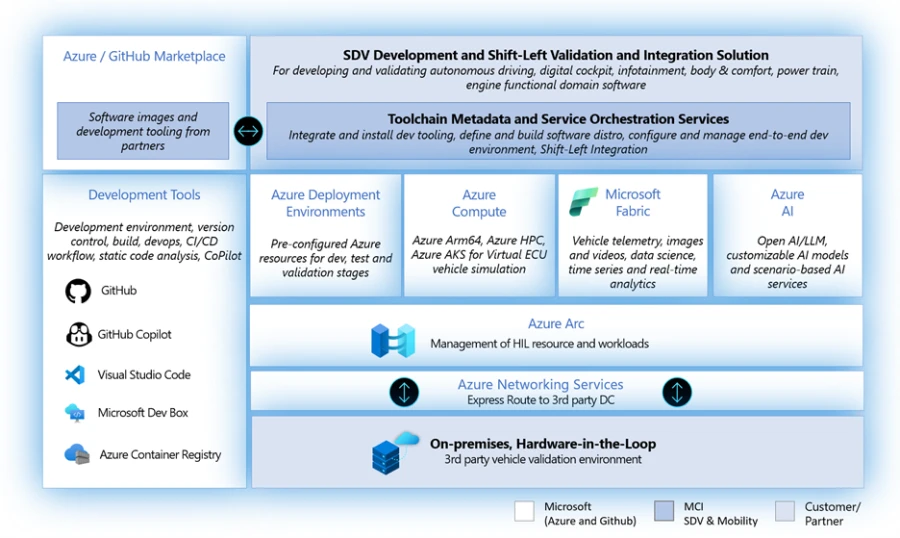
Mobility Copilot reference architecture
The Mobility Copilot reference architecture enables various use cases across the value chain to increase productivity, unleash creativity, and drive innovation with AI. The architecture supports scenarios in research and development, production, marketing and sales, in-vehicle services, and after-sales or repair with cutting edge architecture built on the latest AI models with diverse UX paradigms for optimal customer and employee journeys.
- Copilots for engineering requirements: AI-based assistant to empower engineers to optimize vehicle performance and design from aerodynamics and fuel efficiency to safety and aesthetics.
- Copilots for production quality and efficiency: AI-based assistant that increases production efficiency by analyzing quality data from development, customer experience, production, and other sources to detect quality issues.
- Virtual customer assistant: Conversational engagement for marketing, sales, and customer service channels to answer product-or-concern-related questions, qualify leads, drive sales, and increase efficiency through automation.
- Onboard AI assistant: In-vehicle voice assistants to improve natural language understanding and expand the range of driver and operation interaction.
- Copilots for vehicle diagnostics and repair: AI assistant for automotive repair workshops to improve vehicle diagnostics, streamline maintenance tasks, and offer real-time insights to mechanics.
Mobility Copilots enable the following unique value propositions:
- Best-in-class AI models: Multi-modal enterprise-grade models within Azure based on Azure OpenAI Service, for example GPT 3.5 Turbo, GPT-4, and DALL-E technology.
- One-base architecture: The versatile base architecture addresses a wide-array of use-cases for maximum efficiency and adaptability.
- Easy to plug-in: The architecture can be seamlessly integrated into existing architectures, providing swift deployments.
- Unified data sourcing: Seamlessly integrate multiple data sources including structured and unstructured data.
- Responsible and secure: Azure OpenAI Service instances are isolated from every other customer—the data is not used to train the AI model and is protected by comprehensive enterprise compliance and security controls.
Companies like Mercedes-Benz have already started to implement Microsoft AI-based solutions across the value chain such as production, sales and marketing, and in-vehicle services. Other industry examples include GM, Amadeus, CarMax, and Air India.
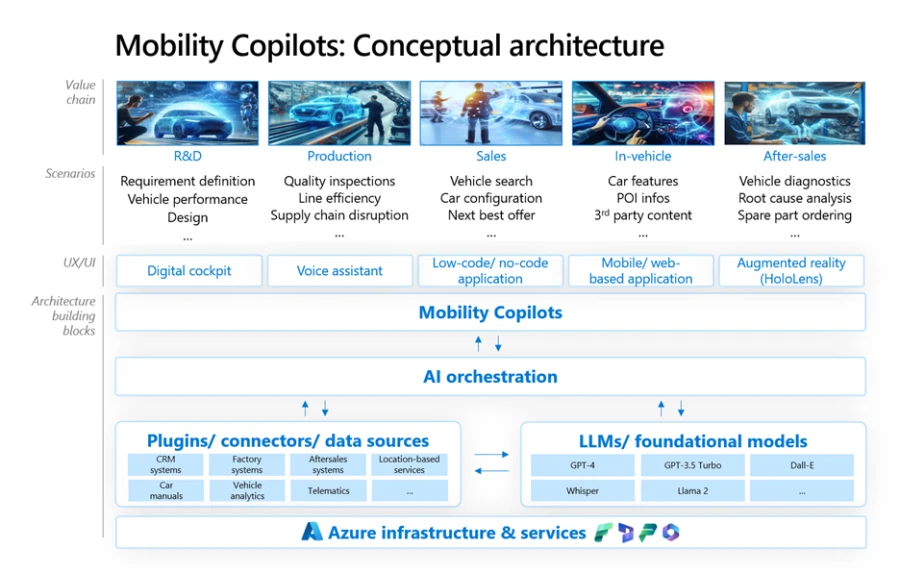
Azure innovation accelerator reference architecture
The Azure innovation accelerator (Azure IX) is an end-to-end cloud solution providing modern, flexible, and secure Azure-based IT infrastructure that is built and maintained by a highly skilled DevSecOps team. The solution can be implemented within six to eight weeks, facilitating fast innovation. This approach optimizes time to value and provides a secure environment for single or multiple companies to collaborate with minimal data management burden. This architecture can be used for various scenarios that require agile collaboration including partner ecosystem enablement, high security environments, short-term quality investments, quick-deployments, or limited IT capability.
This rapid deployment solution offers the following benefits:
- Turnkey solution: Ready-made state-of-the-art infrastructure based on a Microsoft blueprint and environment enables fast roll-out.
- Fully managed solution: To ensure infrastructure is available and up to date without taxing customer resources.
- Security as a service: Microsoft provides various managed security modules available through the platform to service the highest security demands.
- Defined governance model: Defined governance models allow trustful collaboration and joint control of the platform to protect assets and IP.
- Flexible partner collaboration: Enabling onboarding of developers from different companies with different policies to become productive on one joint platform.
- Change built-In: The platform and the managed components provide a flexible change approach based on demands.
- Focus on generating value: Burden of maintenance, change, and administration is low by design through an agile collaboration model.
- Split billing: The cost incurred can be distributed among the partners through defined split.
The Azure innovation accelerator architecture consists of the following elements:
- Azure IX is clustered in platform infrastructure and the corresponding DevSecOps builds and runs a dynamic Azure-based cloud environment.
- The platform infrastructure consists of the mandatory Azure IX Solution Core with embedded processes based on agile principles for security and convenience.
- Azure IX provides base packages for operations tailored to the customer use case.
- Besides the full Azure and Microsoft product stack, the DevSecOps team can run and maintain third party tools and even customer tools by arrangement. The team provides immediate support and resolution for development and operations within one team, a key differentiator amongst the competition.
- The main building blocks of Azure IX are shown in the diagram below.
Within the automotive industry, Azure IX can be used as a base platform to quickly advance all mobility services including SDV, Mobility Copilots, and autonomous vehicle development. One of Azure IX’s first successful use cases has been in advancing autonomous driving development. Advanced driving assistance systems (ADAS) technology needs strong collaboration between various stakeholders in the development of new functions that require a highly flexible, secure environment built for change.
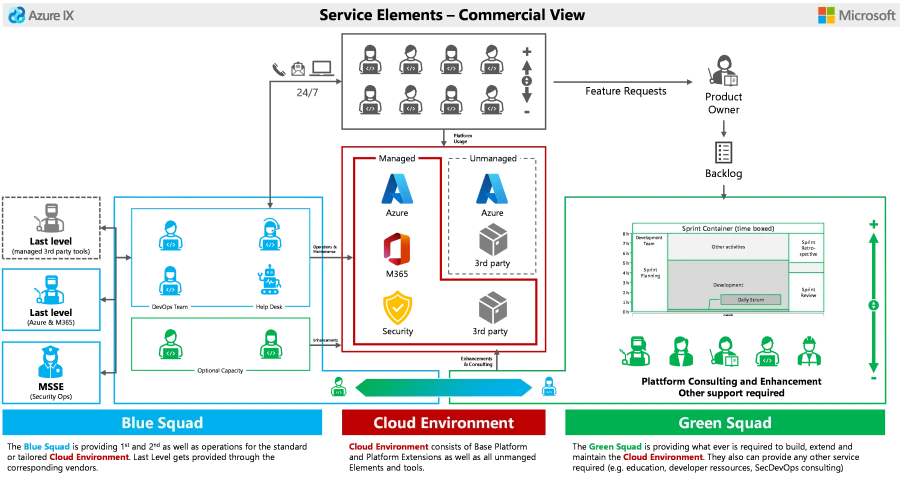
Unified view of the customer reference architecture
The Microsoft unified view of the customer reference architecture brings all sources of customer data together, enabling deep insights and hyper-personalized mobility use cases for automotive and industrial original equipment manufacturers (OEMs) and dealers in travel, aviation, and in mobility-as-a-service. The customer 360 blueprint sets the foundation for a unified customer data platform (such as data integration, pipelines, and consent handing) to combine relevant data sources into one single view of the customer.
Some of the benefits of this architecture include:
- Improved customer experience: The architecture provides a 360-degree view of the customer, enabling businesses to deliver personalized experiences across channels and touchpoints.
- Increased efficiency: By consolidating customer data sources, businesses can reduce the time and effort required to access and analyze customer data with “zero extract, transform, and load (ETL)” integration and “zero-data move”.
- Better decision making: The architecture enables businesses to gain deep insight into customer behavior and preferences, which can be used to make data-driven decisions.
- Increased revenue: By delivering personalized experiences and improving customer satisfaction, businesses can increase customer loyalty and revenue.
- Secure insight: A personalized ID guards customer insights ensuring consent is handled clearly and seamlessly and insights are at the touch of the customer’s digital fingertip.
Unified view of the customer is based on a harmonized data model using Microsoft Fabric to provide customer core data including unified customer identity. The architecture illustrates how live customer interactions are processed through event stream and real-time analytics, then integrated with marketing content to create a comprehensive customer 360-degree profile through Microsoft Fabric. This profile is enriched with data from third-party marketing clouds and central marketing channels, which is then analyzed for insights and recommendations using Microsoft Dynamics 365 Customer Insights.
Customers like Amadeus are leveraging customer centric solutions to create more choice for their customers, better quality service, and smoother trip experiences.

Connected fleets reference architecture
The Connected fleets reference architecture enables faster, lower cost, higher value fleet management solutions—such as asset management and field service—by simplifying value extraction from connected vehicle data, streamlining integration with business systems, and facilitating specialized analytics.
The Connected fleets integration framework enables partners to build value-added solutions with unique capabilities, while also enabling the customer to take advantage of key solutions such as Microsoft Fabric, Microsoft Dynamics 365, and Azure OpenAI Service. This eliminates the need for fractured and expensive solutions built from multiple sources, allows faster development and time to value, and utilizes the Microsoft Cloud to reduce costs. With flexible, standards-based data ingestion, the architecture supports existing connected vehicle solutions, OEM feeds, or data exchanges as appropriate. This flexibility helps to increase scope and reduce cost of vehicle data acquisition.
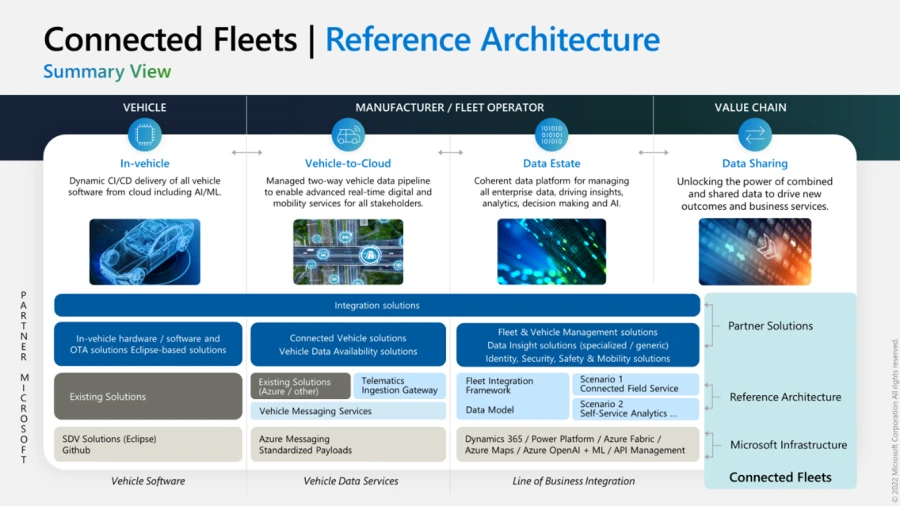
The Connected fleets reference architecture is enabled by the following partners: Accenture, Cognizant, Connected Cars, DSA, Hitachi Zero Carbon, HCL Technologies, Luxoft, Mojio, Netstar, STZRE, and TomTom. A live instantiation of the power of composing multiple partner solutions together is now available and underpins a new demo shown first at CES 2024, as illustrated in the following graphic:
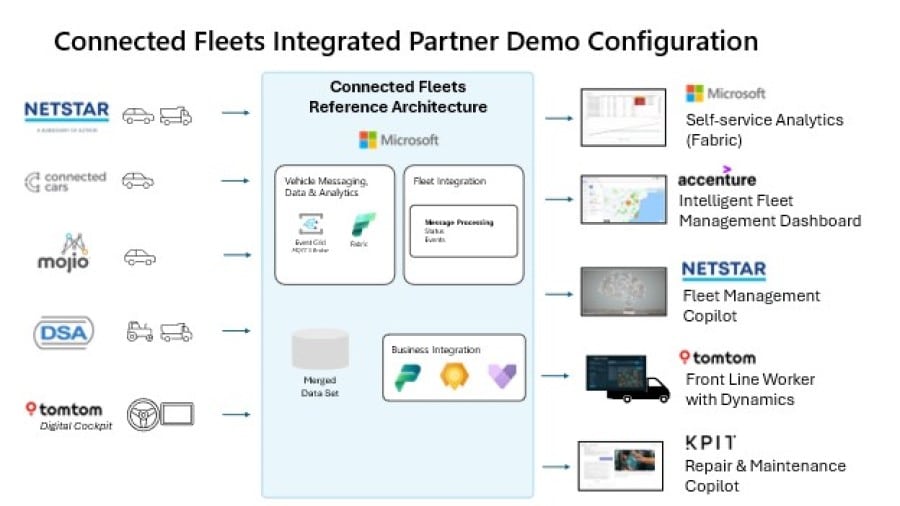
Autonomous vehicle operations reference architecture
The autonomous vehicle operations (AVOps) reference architecture provides an integrated, end-to-end workflow for developing, verifying, and improving ADAS and autonomous vehicles (AVs).
Industry-leading Microsoft Azure cloud services are provided to integrate with your tool chain, while our partners complete a strong, industry-vetted global, secure, and hyper-scale cloud-based development platform that spans development, validation, runtime deployments, and feedback loops.
Regardless of level of autonomy, developing a self-driving software stack and bringing a new car to market presents a series of workflow challenges:
- Efficient ingestion of terabytes or even petabytes of data daily generated by fleets of test vehicles.
- Software and AI update requires validation through simulation with massive amounts of computing power.
- Petabytes of data and peta-scale computing is expensive—delivering on time and within budget is challenging.
- How do you accurately validate and test performance?
AVOps provides a templatized digital testbed that can be spun up on demand, shared across the entire value chain, and used to shorten time-to-market. This approach helps our automotive customers transform themselves into software and AI companies.
The architecture also helps optimize operational ADAS and AV workflow coordination and feature development, verification, and validation through:
- DataOps: From edge to cloud, the orchestration of petabytes of data to support parallel workstreams.
- DevOps: Scaling the continuous integration (CI) and continuous delivery (CD) pipeline.
- MLOps: Scaling machine learning pipelines and integrating with CI and CD pipelines.
- ValidationOps: The ability to accurately simulate software and AI updates across all edge cases.
How generative AI can help
The white paper “Enhancing efficiency in AVOps with Generative AI” explores how generative AI can help reduce the complexity, cost, and time of developing and testing autonomous driving systems across simulation, validation, optimization, and personalization. Use cases include generating synthetic scenarios, validating sensor data, optimizing driving behavior, and personalizing user experience.
The AVOps reference architecture provides a collaborative, open framework built on common processes that helps automate, manage, and closely monitor the validation processes for software and hardware deployment. The following Microsoft partners provide additional value-added capabilities to this framework: Ansys, Akridata, Applied Intuition, Cognata, dSPACE, and Linker Networks.
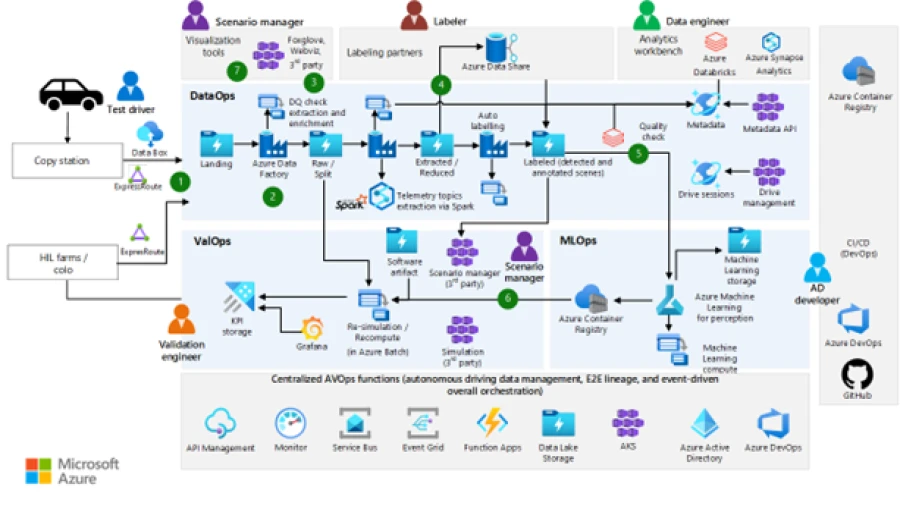
Digital selling reference architecture
The digital selling reference architecture enables reinvention of the traditional customer journey by transforming real-life spaces into an immersive and interactive digital environment that reaches a wider range of customers.
The reference architecture enables unique, efficient, and immersive ways to engage with consumers by unlocking the power of the metaverse to improve communications, sales, and operations. Enhanced by partner capabilities, focus areas include digital marketing, e-commerce, high-fidelity 3D rendering, and industry-specific systems. By integrating disparate data from the customer, field service, and dealer management systems, improved visibility, collaboration, and data insights can drive more personalized, multi-channel customer experiences. Through the digital selling reference architecture, cloud and partner capabilities, OEMs, dealers, and mobility, service providers now have the flexibility to enhance in-person interactions along with enabling new digital customer engagement models.
The following announcement by Fiat highlights the transformative impact of digital selling.
A group of curated expert partners will drive innovation while providing excellence in omnichannel fulfillment, immersive and virtual user experiences, and end-to-end process coverage. These partners include: Sitecore, Adobe, Touchcast, Annata, and Stella Automotive AI.
Reinventing the customer journey
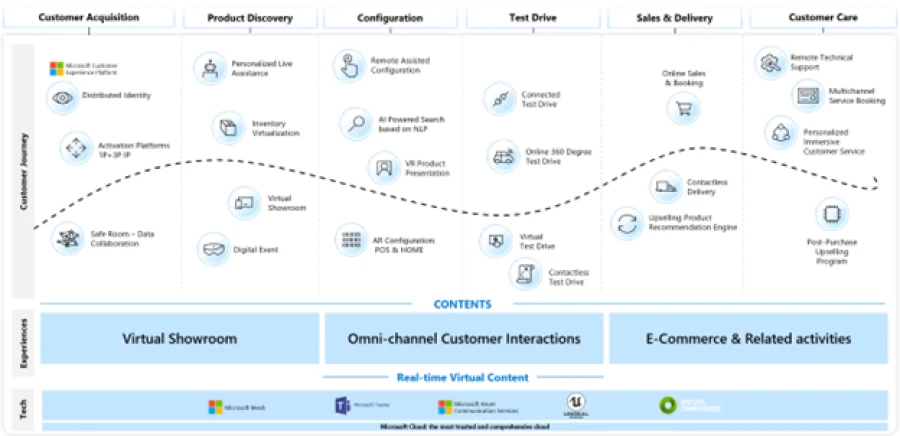
Microsoft in mobility and manufacturing industries
- Explore Microsoft solutions in mobility and Microsoft Cloud for Manufacturing.
- Learn more about Microsoft reference architectures for mobility and manufacturing.
The post Accelerate automotive transformation with new solutions from Microsoft appeared first on Microsoft Industry Blogs.
Source: Microsoft Industry Blog
